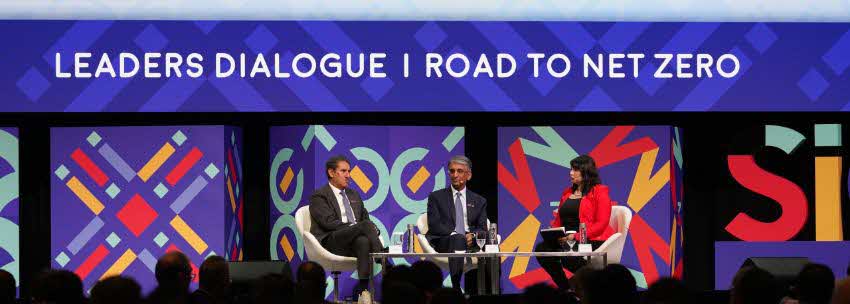Governments and financial institutions are foundational to overcoming challenges in the energy transition.

Amid the widespread commitments to the energy transition, it's coming increasingly apparent that the world is facing a multitude of formidable challenges. These challenges took centre stage during the inaugural Leaders Dialogue: Road to Net Zero that took place on 23 October at SIEW 2023. Esteemed speakers Dilhan Pillay Sandrasegara, Executive Director and Chief Executive Officer, Temasek, and Francesco La Camera, Director-General, International Renewal Energy Agency (IRENA), provided valuable insights.
Accelerating grid infrastructure development to support renewables
One key challenge brought up was the need for urgent need to accelerate deployment of physical infrastructure—namely in the transmission network and energy storage systems—to meet the ambitious targets for installed capacity of renewables. Mr La Camera underscored that staying within the 1.5 °C target necessitates adding approximately 1,000 gigawatt (GW) of renewable capacity annually until 2030. He also highlighted the cascading impact if these annual targets are not met, since the shortfall would need to be made up for in subsequent years. Integrating these renewables into the grid not only impacts grid capacity, but more importantly, grid stability. As such, governments and financial institutions play pivotal roles in accelerating infrastructure development:
- Governments. They will be instrumental in enabling policy frameworks to address permitting and licensing issues, which in turn facilitate infrastructure development.
- Financial institutions. Their investments in grid assets will be essential in realising infrastructure development.
Philanthropic capital crucial to ease carbon abatement costs
Mr Sandrasegara stressed the importance of bringing down the carbon abatement cost curve and making the energy transition financially viable and appealing to investors. In the lead-up to COP28, the financing gap is still significant. Subsidies play an important role in accelerating the adoption of low carbon solutions in the market.
At the same time, strategic investments are needed to address the challenges posed by the energy transition. For example, Temasek invests in technologies that enable safe transportation of hydrogen and overcoming its transport infrastructure challenges. Such investments ensure sustainable returns in the long run.
Given that Temasek invests in hard-to-abate sectors such as airlines and shipping, it needs to balance this out by investing in climate-aligned opportunities. Temasek will also continue to invest in carbon-emitting companies as long as they demonstrate a commitment to decarbonisation.
Enabling the workforce for a just transition
Mr Sandrasegara highlighted that beyond enabling infrastructure development through green financing, the economic impact of the energy transition must also be accounted for. He emphasised the need to consider the current workforce. In Southeast Asia, where some 60 percent of energy is derived from coal-fired plants and a significant portion of the workforce depends on coal and fossil fuels, transitioning the workforce is crucial to keep pace with the evolving energy landscape.
Mr La Camera added that having a skilled and capable workforce is critical to enable the energy transition. This requires that universities and education systems adapt and build up the necessary training for the workforce. Once infrastructure and finance are in place, the workforce can be upskilled to pave the path to net zero.
The Leaders Dialogue bought to light several key challenges that necessitate collaborative efforts from governments and financial institutions. Only through a collective approach as we navigate these challenges together can we ensure a smoother energy transition, securing a sustainable future to look forward to.